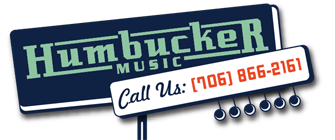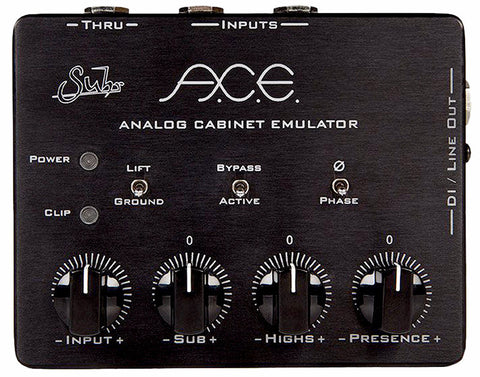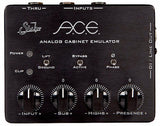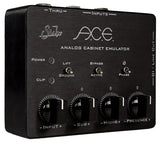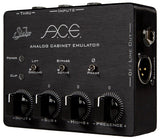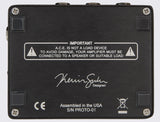Suhr ACE Analog Cabinet Emulator
- DESCRIPTION
The Suhr ACE, which stands for Analog Cabinet Emulator, is an super handy device that we're quite excited about. It essentially eliminates the need for a microphone while recording or playing live.
But wait... What makes this cab emulator different? Why buy the Suhr ACE?
Glad you asked! So, the ACE is a 100% pure analog signal path from start to finish. It utilizes an advanced Multi-Stage Filtering circuit that sounds true to life without all the loss of warmth, punch and character from using digital processors. If you spent a fortune on a fine tube amp and pedal board, why lose it all to digital when you record or gig? That's plain crazy!
The Suhr ACE also features an impressive EQ circuit for fine tuning your tone. In designing this, Suhr started with a 4x12 cab loaded with Celestion Greenbacks as a baseline. Using the EQ, you can shape the tone to sound like different speakers and configurations. The possibilities are practically endless.
As far as connectivity, the ACE comes with an impressive set of interface features.
A) Inputs: From your amp, you can connect two different ways: 1) From amps powered output, or 2) if your amp has a line out, you can go from that into the ACE via its line level input.
B) Outputs: 1) Balanced XLR out, 2) Balanced 1/4" TRS *OR* Unbalanced 1/4" Mono outputs.
C) Thru: 1) The ACE's "Thru" output is for connecting a speaker cab if necessary. Remember: If you are using a tube amp, you must provide a load of some sort. Either by using an actual speaker cab, or by using a Suhr Reactive Load.
The Suhr ACE also features a few handy switches that we'll go over.
1) Lift / Ground: Like any other Ground Lift, If you're using this device and the power from the wall is causing a hum, just flip this to eliminate it.
2) Bypass / Active: Just as it says. You can either have this in effect, or bypassed
3) Phase: We're not really going to go into phase cancellation and all the physics behind it (Google "Phase Cancellation" if you want that discussion) but this allows you to reverse the phase of the signal if it's conflicting. You will probably only have to worry about this if you are using a mic at the same time. For instance, if you're laying down multiple tracks or you want to blend a mic'd cab with the signal from the ACE. Otherwise, ignore this switch.
But wait... What makes this cab emulator different? Why buy the Suhr ACE?
Glad you asked! So, the ACE is a 100% pure analog signal path from start to finish. It utilizes an advanced Multi-Stage Filtering circuit that sounds true to life without all the loss of warmth, punch and character from using digital processors. If you spent a fortune on a fine tube amp and pedal board, why lose it all to digital when you record or gig? That's plain crazy!
The Suhr ACE also features an impressive EQ circuit for fine tuning your tone. In designing this, Suhr started with a 4x12 cab loaded with Celestion Greenbacks as a baseline. Using the EQ, you can shape the tone to sound like different speakers and configurations. The possibilities are practically endless.
As far as connectivity, the ACE comes with an impressive set of interface features.
A) Inputs: From your amp, you can connect two different ways: 1) From amps powered output, or 2) if your amp has a line out, you can go from that into the ACE via its line level input.
B) Outputs: 1) Balanced XLR out, 2) Balanced 1/4" TRS *OR* Unbalanced 1/4" Mono outputs.
C) Thru: 1) The ACE's "Thru" output is for connecting a speaker cab if necessary. Remember: If you are using a tube amp, you must provide a load of some sort. Either by using an actual speaker cab, or by using a Suhr Reactive Load.
The Suhr ACE also features a few handy switches that we'll go over.
1) Lift / Ground: Like any other Ground Lift, If you're using this device and the power from the wall is causing a hum, just flip this to eliminate it.
2) Bypass / Active: Just as it says. You can either have this in effect, or bypassed
3) Phase: We're not really going to go into phase cancellation and all the physics behind it (Google "Phase Cancellation" if you want that discussion) but this allows you to reverse the phase of the signal if it's conflicting. You will probably only have to worry about this if you are using a mic at the same time. For instance, if you're laying down multiple tracks or you want to blend a mic'd cab with the signal from the ACE. Otherwise, ignore this switch.

